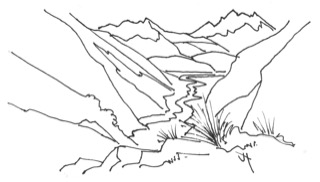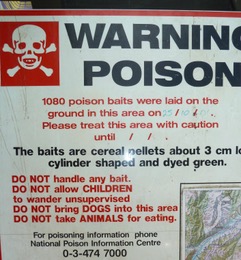by Reihana Robinson spokesperson for the Upper Coromandel Landcare Association (UCLA)
There are Big Losers in DoC’s Coromandel 1080 drops – LOCAL ECONOMY, TOURISTS, HUNTERS, TRAPPERS
THE WINNERS are AERIAL 1080 POISON COURTESY DEPARTMENT OF CONSERVATION
For readers new to the Coromandel, this report will be 100 percent new information. For the rest of us, we understand we are locked into the aerial 1080 poison cycle courtesy of the Department of Conservation (DoC).

Our beloved maunga Moehau is to be assaulted again by aerial poison 1080. The Upper Coromandel Landcare Association (UCLA) has consistently called for humane wild animal control, creating both jobs for locals and a healthy native bush. But government after government and their funded proxy eco groups continue to push cruel toxins.
Eco-FX (bought in 2022 by global pest business Rentokil) is contracted by DoC to dump monosodium fluoroacetate (1080) baits from helicopters in 2025. How does this help our local economy?
With the millions spent on aerial operations imagine the possible numbers of locals employed checking rat, stoat and possum traps on the Moehau tracks.
Wild pigs may eat poisoned carcasses so pigs cannot be hunted for meat for the table. Whanau miss out. Kai that is readily available to hunters and trappers will be banned and wild pigs left to die a gruesome death.
In earlier decades the DoC made attempts to survey the numbers of rats and possums to help determine whether a 1080 poison drop would be necessary. Now no such surveys are carried out.
New Zealand uses the bulk of this dangerous poison manufactured in Alabama USA. It is designed to interrupt the Krebs cycle which affects all oxygen-breathing creatures, including birds such as ruru and hawks that eat poisoned possums or rats. Toxin 1080 leads to excruciatingly prolonged deaths for animals and birds.
That New Zealand’s unique and decades-long use of the powerful toxin 1080 has proven an expensive failure in safely and efficiently meeting conservation goals is increasingly clear.
In assessing the results of New Zealand’s 60-year toxin campaign, one fact stands out among all the rest—there has been no sound scientific research whatsoever that conclusively demonstrates ecosystem improvement as a result of aerial 1080 operations.
Anecdotes abound, and studies by industry-associated professionals are common. But scientific research that meets internationally recognised standards does not exist to show that poison use has either improved overall ecosystem health or directly resulted in long-term population benefits to any individual native species.
In respect of its main target, the poison has failed to eliminate, or even significantly reduce, the country’s brushtail possum. Possum numbers were estimated in the tens of millions when 1080 poisoning began. After more than a half-century of toxin use, population estimates still range from 30 to 40 million individuals. And with repeated spreading of the toxin, bait shyness in possums has developed and is now generally recognised. Lethal effects on non-target native species are documented—from tomtits and robins to kea, kaka, morepork and insects.
Populations of rats, known predators of a wide range of indigenous species, have been found to dramatically increase within 24 months, following aerial applications of the toxin. And even more troubling, increasing resistance in rats to 1080 toxin is now suspected.
Local Māori believe such poison use is not consistent with kaitiakitanga. “Ngati Huarere ki Whangapoua Trust supports the use of hunting, trapping and cyanide only.” And Frances Henare states “In August 2021 with the mana whenua vested in me by Rongo-U o Pa-tu-tā-tahi iwi, I placed a rāhui over Moehau to protect the mountain and our wellbeing from poisoning.
Long-time west coast farmer Theodora Ward says “Rachel Carson… in her book “Silent Spring” warned of pesticides causing irrevocable damage to all living creatures and to the world. Those warning signs are in this country.”
We all know how long environmental struggles can be and we all live in a country still using glyphosate.
Kevin Prime (Ngati Hine) clearly states “About 15 years ago I was asked ’how would ancient (pre-European) Māori have addressed the possum problem in a culturally appropriate manner if possums had co-existed with them?’ My views have not changed. The answer is simple. Māori would not have seen excessive possum numbers as a problem at all. Instead the possum would have been considered an extremely valuable resource in many ways.”
Please speak up against cruelty to oxygen breathing animals, birds and insects.
Please call your local MP: Scott Simpson (0800 7273 6282 or 04-817 9999). Tell the local police of your concerns (105)
Question all local candidates. While they have no real power on this issue they can choose to lobby on behalf of residents.
HISTORY
The Upper Coromandel Landcare Association (UCLA) arose in 2006 when “farming families around the Moehau Range north of Colville were served with a plan to physically fence them into a sprawling new 18,000-hectare eco-management zone…creating a coast-to-coast steel barrier”. DoC, Regional Council and the ratepayer funded Moehau Environment Group (MEG) collaborated on the plan. Had MEG read their own commissioned cost-benefit study: An Analysis of the Costs of Pest Control Operations in the Northern Coromandel by Sandra Barns they would have read learned of the “likelihood of reinvasions and ultimate project failure.”
Eighty-five percent of those living around Moehau supported a Statement of Opposition to the barrier that cited, among other concerns, the certainty of blanket applications of toxin 1080 over the entire area. Despite successful opposition to the well-intentioned, but hare-brained pest-fence project, the three-yearly poison cycle of aerial 1080 got underway, promoted by DoC and Regional Council.


It is astounding and pathetic how DoC pulls the wool over politicians eyes about the supposed ‘invasive pests.” It has to go down as one the biggest con jobs, public servants have pulled.
Note the pattern, every few years DOC has to poison again for as Reihana Robinson says, “Populations of rats, known predators of a wide range of indigenous species, have been found to dramatically increase within 24 months, following aerial applications of the toxin.”
New Zealanders will go down as the poisoned society literally. Poison poison poison in the parks and reserves in the bush in your food. Annually the Waikato Region gets 50 tons of poison concentrate and the only success is the destruction of the soil biology to insect life to the birds, to the water fowl, fish life and now the people. 74 people are informed daily “you have cancer”. The much vaunted RMA has been the death knell of innovation and employment and now the environment.